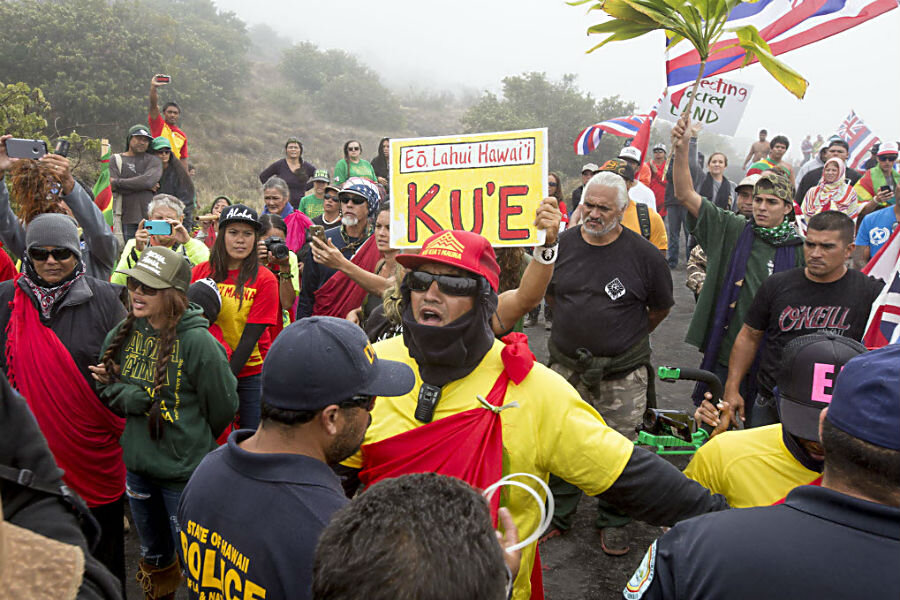Why native Hawaiians are saying no to a $1.4 billion telescope
Loading...
If everything goes according to plan, a powerful telescope with the potential to change astronomy research as we know it will soon be erected atop Hawaii's tallest mountain, Mauna Kea.
There's just one thing standing in the way of the scientists building it: a small but scrappy group of native Hawaiians who are fighting back against construction on the mountain, which their cultural tradition reveres as sacred.
Mauna Kea, home to more than 250 shrines and burial sites, is said to be the place where the mother and father of the Hawaiian race first met. Activists say the $1.4 billion, 18-story-high Thirty Meter Telescope (TMT) will ruin the beautiful scenery and spiritual power of the mountain.
“Mauna Kea in every respect represents the zenith of the Native Hawaiian people’s ancestral ties to Creation itself,” native Hawaiian activist Kealoha Pisciotta wrote in a post for the Hawaiian Environmental Alliance. “When the land, the waters, the life forms suffer, we feel this suffering, the process of creation begins to un-ravel and de-creation begins ... We lose our place in time and space and then we are lost.”
The war between scientists and activists has been ongoing for the past seven years, but escalated in recent months as construction began. As Hawaiians across the state debate whether the jobs and tourism brought by the TMT are worth it, a smaller subsection of local people have been taking action.
In April, 31 protesters were arrested on the mountain during the first attempt to transport building materials to the site, causing Gov. David Ige to temporarily halt construction, according to Honolulu Civil Beat. After he gave the go-ahead to resume the project last week, a dozen more protesters were arrested for refusing to move out of the way of construction crews.
In late August, the Hawaii Supreme Court will hear oral arguments in a case that will determine if the University of Hawaii was correct in issuing a conservation district use permit for the building of the Thirty Meter Telescope. The plaintiffs are appealing an earlier ruling by a Circuit Court judge who said the permit was issued lawfully.
In a column for the New York Times, science writer George Johnson describes the native backlash as a "turn back toward the dark ages" and laments the fact that "Indian creationism is tolerated out of a sense of guilt over past wrongdoings. Again the spiritual is inseparable from the political."
Reactions such as Mr. Johnson's have prompted defensive responses from native Hawaiians on social media.
“Any time Hawaiians – or any other native people, for that matter – come out in force to push for more respect for our culture and language or to protect our places from this kind of destruction, we are dismissed as relics of the past, unable to hack it in the modern world with our antiquated traditions and practices,” writes Bryan Kamaoli Kuwada, a PhD student at the University of Hawaii at Manoa, in a blog post.
Organizers of the project say they’ve done all that they can to alleviate the impact of the telescope. They have held more than 20 community meetings to get feedback from locals, and promise to give $2 million per year once the telescope is built to go toward upkeep of the mountain, science and technology education on the island, and the state's Office of Hawaiian Affairs, which protects native Hawaiian interests.
They say they've also gone through all the legal channels necessary to get the project approved, including the environmental assessment.
“Look, we made a lot of adjustments in how we do business there,” Michael Bolte, a professor of astronomy and astrophysics at the University of California at Santa Cruz and one of the main organizers for the TMT, told BuzzFeed in April. “But there are zero legal barriers here. Someone standing in front of your bulldozer is not a legal issue.”
Not all native Hawaiians are opposed to the project. In an essay for local newspaper West Hawaii Today, Chad Kalepa Baybayan argues that science and tradition aren’t necessarily mutually exclusive.
“Our ancestors … sought knowledge from their environment, including the stars, to guide them and to give them a greater understanding of the universe that surrounded them,” Mr. Baybayan writes. “The science of astronomy helps us to advance human knowledge to the benefit of the community. Its impact has been positive, introducing the young to the process of modern exploration and discovery, a process consistent with past traditional practices.”








